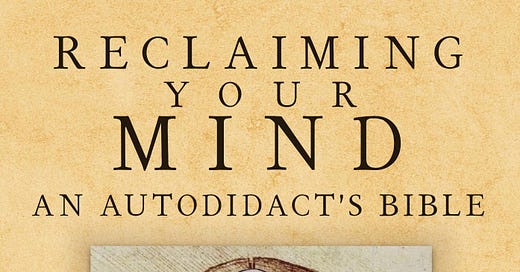This is the seventeenth installment of the serial of my forthcoming book Reclaiming Your Mind: An Autodidact’s Bible. As with other installments, part of it is behind the paywall. Become one of my supporters to get the whole thing.
Catch up on earlier installments here:
#1, #2, #3, #4, #5, #6, #7, #8, #9, #10, #11, #12, #13, #14, #15, #16
If your email client chokes on this post, find the whole thing at http://jdanielsawyer.substack.com
Chapter 4
Making it Stick
Memorization and Memory Tools
Some people, cursed be their twisted little souls, remember everything effortlessly. The rest of us have to work at it one way or another. So let’s spend few pages looking directly at tools and techniques for making things stick in your noggin so that you have access to them more-or-less on demand.
Mnemonics
A mnemonic is a device that helps you remember, and ranges in forms from couplets to ditties to parables.1 A mnemonic can literally be anything that aids recall, but there are really only a few broad ways to game memory with mnemonics.
Associative Mnemonics
Imagine:
You live in East Berlin, and it’s 1972. The local Stasi section head has learned that an enemy of the Soviet state has shown up in West Berlin. In light of your sterling record as a stone-cold sniper in World War 2, the local head of the Stasi has volun-told you to go and kill the bastard.
To do this, you must assume the identity of a westerner who has been visiting East Berlin. You’re in your sixties now, and look very non-threatening. You’re the perfect man for the job. Annoyingly, though, you live in East Berlin, you haven’t even held a gun in decades. “Don’t worry about the guns,” the Stasi boss tells you, “just go down to the police range.”
But that’s not your only problem. You’ve never been undercover, not even during the war. Even if you had, that was forty years ago when you were in your early twenties. Still, you must find some way to memorize your new legend (i.e. your cover identity’s name and backstory).
When you get your legend, you learn that your new name is Heiko Goldberg. Heiko is easy enough for you to remember—you had an uncle named Heiko, and he always wore a bowler hat and frock coat. You decide to dress in a bowler hat and trench coat, using the dress-up to help you slip into the name.
The “Goldberg” part of the equation is much more difficult. It’s a Jewish name, and you’re not Jewish. You were a soldier in the Nazi army, and you were trained to find Jews disgusting and contemptible—and your intervening years under the Soviet boot-heel have not softened your opinion of Jews, especially Jewish philosophers like Marx. But you have a job to do, and you need a way to remember your name, so before you embark on your mission you find a rare moment of privacy and pull a shoe box out from behind a rotted-out panel in your apartment’s single bedroom. You fish out your grandfather’s wedding band—a gold ring—and find it just fits your right pinkie finger. Unusual, but you can make it work. Now, every time you shake someone’s hand, you will feel the gold ring, and remember that your name is “Goldberg.”2
Our fictional spy thus builds himself a safety net of mnemonics. By arranging his habits and dress so that he would be forced to run into things (the clothes, the ring) that would remind him of his legend, and by rehearsing in his mind the reasons those tangible items remind him of the story he needs to remember, he creates a sort of memory prosthetic that works by association. Hence, associative.
Associative mnemonics take advantage of the web-like quality of knowledge and memory. The more hooks you can get into the web, the more pathways you have to find the thing you’re trying to remember. In the example above, the links between the mnemonics and the things they’re meant to symbolize are concrete and strong, so even though there’s only a single point of contact for each mnemonic, it’s a good solid point. Multiply those points of contact and the mnemonic gets stronger.
Of course, you can always try a very loose association, such as in the proverbial “string tied around the finger” gag that plays a part in so many old movies and cartoons: a character ties a string around his finger to remind him of a task, then vividly remembers that he tied the string on in order to remind him of something, but invariably forgets what he was supposed to remember. Your mileage with loose associations may vary.




